Charles the blacksmith
Charles was born in 1839, the eldest of Charles the carpenter and Jean Galloway’s four children. He was born at Menstrie in Logie. Charles lost his father around the age of 10 and his mother was a pauper having to work in a mill whilst bringing up 4 young children.
Charles might have ended up a carpenter like his father had events been otherwise. Perhaps Charles’s father would have ensured a comfortable upbringing for his children as he was reasonably well paid. However, Jean sent Charles to live with her own elderly mother and her brothers John and Robert. He learned to be a smith as that was their occupation. Charles became a journeyman blacksmith in time, the highest qualification possible. In 1861 he had attained this qualification and was working as a smith at Fowlis Wester (probably at New Fowlis) with his mother and brother and sister William and Elizabeth.
The just released 1865 Valuation Rolls are of no help regarding Charles- there is no tenant in Perthshire of that name. This suggests he was living with his mother and or the Galloways before he married.
In December 1866 Charles married the red haired, Gaelic speaking and fiery tempered Jane Ann Clark. Jean was pregnant with their first child, John, by the time they married at Huntingtower near Tibbermore. I presume she was working at Huntingtower Castle and living there or at a nearby house. Charles was living at Buchanty at the time. Charles’s brothers William and Peter witnessed the wedding.
On the 1871 census he, Jane and their family were living at Buchanty Village in Logiealmond. A group of houses lie together by the river a half mile or so from Glenalmond House. Since the birth certificates for children (1867 and 1870) state that they were born at Milnrodgie this helps us establish the location. I visited what I was told was the forge some years ago. Recently I have seen the building marked as a sawmill on a 19th century map, however. Perhaps the house had been a sawmill first. Scotland’s People has Valuation Rolls available to the public, for a fee. The first is for 1875 and Charles Douglas is not named as a tenant. Of the dozen or so houses there are tenants listed for around half whilst the rest are described as being held by “various” tenants. Perhaps Charles shared one or he may have moved on already. In any case no Charles Douglas is a tenant on the Valuation Rolls in Perthshire in 1875.
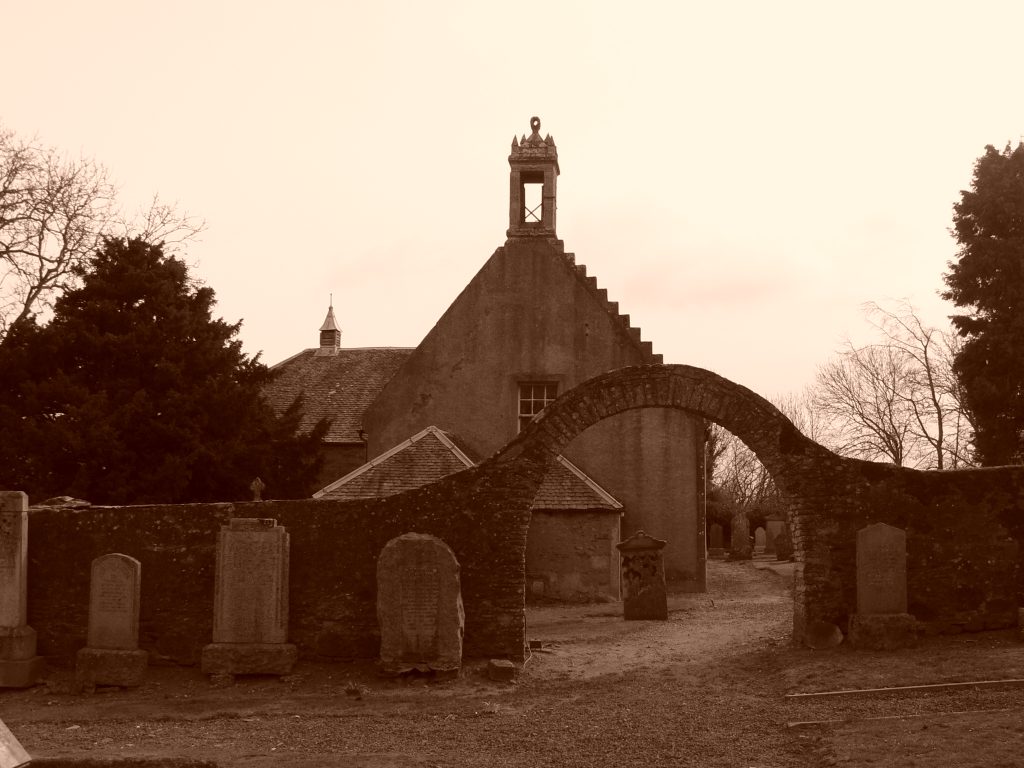
The church at Tibbermore. It is likely that Charles and Jane Ann Clark did not marry in the church itself.
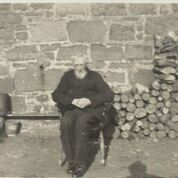
Photo above from Anne Richardson in Scotland is of Charles Douglas the blacksmith, seemingly in old age. I am not sure if it was at East Cultmalundie or elsewhere. I presume it was taken after his wife died in 1918 as she is absent. Certainly he appears to be very aged.

Above: Strathearn Herald on 10th August 1918 carried the death notice for Jane Ann Clark. Ages given at death are often inaccurate but this age of 77 is consistent with the marriage record and census returns. It does suggest that she was born around 1841-2 and that the Jane Ann Clark whose baptism was registered in 1836 was an older sister who died.
The house and smithy at Tullybannochar were rented by Charles from Sir David Dundas of Dunira (his son Sir Sidney James Dundas from 1876) for £14-0-0 per year between 1874 and 1890. When the 1881 census (Census 341/00 005/00 006) was taken the family were living at the same house, which is now a silver smith’s house. The yearly rent or value was £12-0-0 in 1885. In 1881 there was a servant named Ann Stewart living in the house; Ann was apparently born in Monzievaird Lunatic Asylum. Interestingly, an Ann Stewart was living at Clathy Park in 1851. Did she (or her family) know the McKerachers and find employment through this connection with the Douglases? She must have been held in high esteem as a grandchild was named after her.
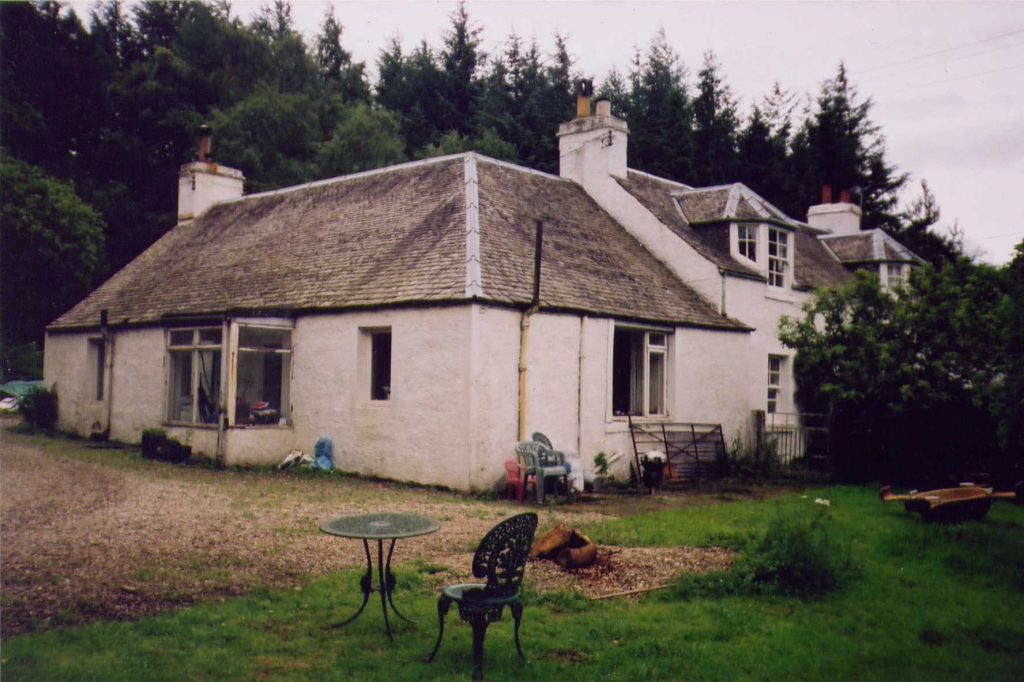
The smithy at Tullybannochar
Below: aerial view of the smithy at Kinkell, from Canmore Archaeological Services:

http://mapfling.com/q3dw6o4 Hopefully this will open a Google satellite map showing places linked to Charles Douglas the blacksmith and his family.
You have to copy and paste the address into an email to yourself and then open the email and click on it. Let me know if it doesn’t work, please.
On 17th November 1900 Charles Douglas took out an advert in the Dundee Courier for another blacksmith to join him. I am unclear if this was for a 1-3 year term or if he was looking for someone with that length of experience. Son in law Alexander Fergusson may have decided to move on by this time or Charles may have recognised that he was not as string as he used to be.

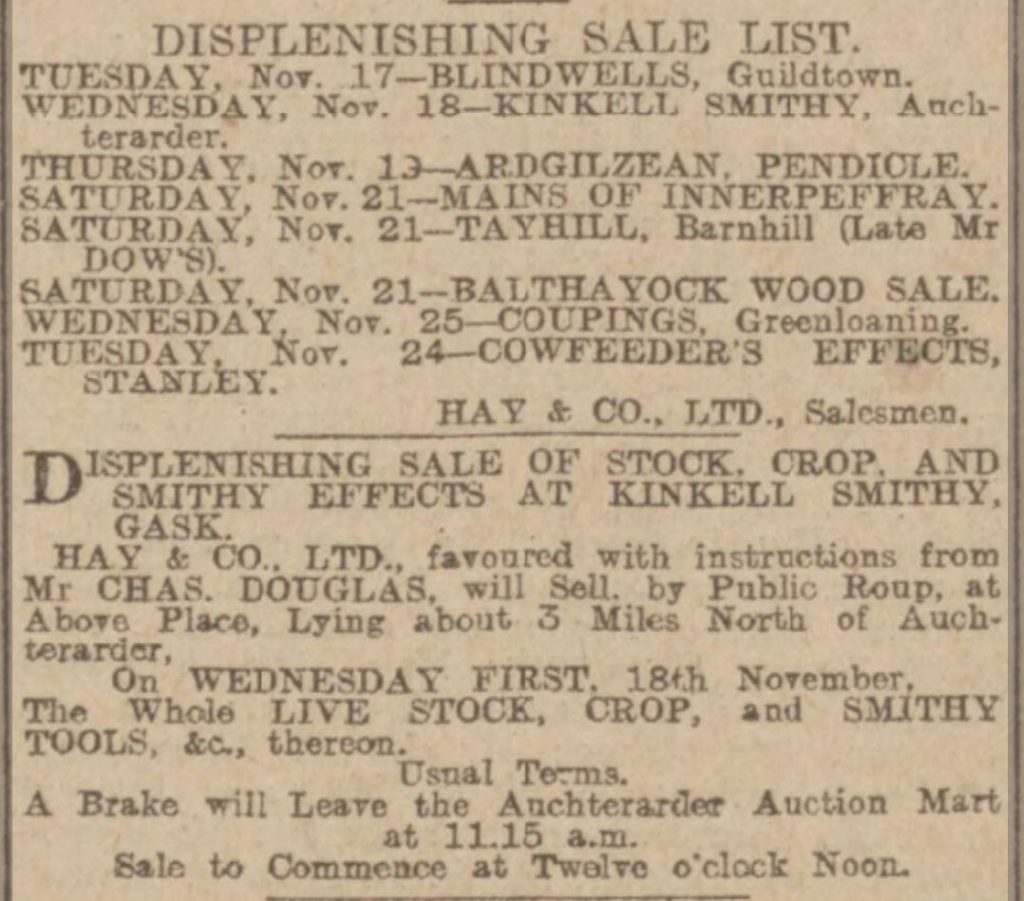
The advert above is notice of his retirement and selling of stock:
Kinkell Smithy from the other side of the Kinkell Bridge

In 1905 Charles is shown as renting 3 properties: the house and smithy at Kinkell (still), the pendicle at Kinkell Bridge along with the house and smithy at Crosshill (with £10 of land). Rent for this was £5-5-0. Once again, Alexander actually occupies one of these, that Crosshill. This property was owned by the Earl of Perth.
On the 1911 census Charles, Jane, adult son Peter and young grandson Peter Ferguson were living at 1 Woodside Cottage, Blackford. Presumably he had now retired as he was not living at a smithy and in 1915 Charles was no longer even a tenant in Perthshire. He had moved into the Old Toll House at Tullibardine (part of the Strathallan Estate). So Charles and Jane were together again, as this is where she died of influenza in August 1918 (SR 333/00 0013). Charles lived on until February1928, dying at East Cultmalundie. This was now the home of his daughter Jane Ann Clark who had married a John Nicoll. Charles’ death was ascribed to senile decay. The Nicolls had lived at a house at Huntingtower in 1920, paying £5-4-0 to Lumsden and MacKenzie yearly. Ishbel and Douglas McEwan have told me that their mother travelled on her own by train to stay with the blacksmith around 1910-1912 at Kinkell. It must have been between 1910 and 1911 as in 1912 Charles was living at Woodside Cottage. She remembered there was a wood behind the cottage.
She described Charles as being a tall man. He was not broad, rather more lean but he must have been strong.
George Patton
My thanks to Colin Douglas for the details of this story. I knew of George Patton but had thought the incident below was in the 1830s or 1840s and at a time when no Douglases lived at Glenalmond so I am grateful for this information.
The owner of the Milnrodgie estate in the mid 19th century was William Patton. His heir was George Patton who had been educated at Perth Academy and Oxford, where he did not complete his degree. He then read Law at Edinburgh and by 1859 was Solicitor General for Scotland. He became MP for Bridgewater in Somerset in 1866 but faced accusations of bribery and corruption. A commission of inquiry damned him, by which time he had inherited Glenalmond and was living at Glenalmond House part of the time. On 18th September 1869 George and his wife returned to Glenalmond from Edinburgh and he spent hours with his forester.
On the morning of Monday the 20th September he rose at 8 and went for a walk before breakfast but did not return. On the north bank of the Buchanty Spout he took a razor from his pocket and cut his throat before jumping into the swollen river. Estate workers found the empty razor case and his tie on the river bank and they searched until the Friday before finding his body.
It is very likely that Charles Douglas the blacksmith was one of the workers who searched for him during those 5 days.
Generation VIII: Family of Charles Douglas and Jane Ann Clark
Charles and Jane had a large family, all of whom survived to adult ages.
1. John Douglas, 1867-1930
2. Charles Douglas, 1868-1907
3. William Galloway Douglas, 1870-1941
4. Elizabeth Douglas, 1871-1941
5. Jean Anne Douglas, 1872-1958
6. Jane Clark Douglas, 1874-1946
7. Peter Douglas, 1876 -1929
I found this photo, I think from NLS, of West Cultmalundie Farm. Unfortunately there is none of East Cultmalundie. This is close to the farm of John Nicoll, where Charles Douglas the blacksmith died. Copyright Peter Gamble.
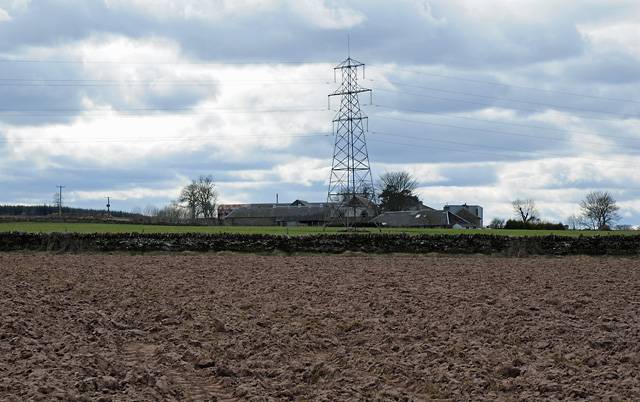
The smithy or sawmill at Milnrodgie; the family may have occupied an estate house, too
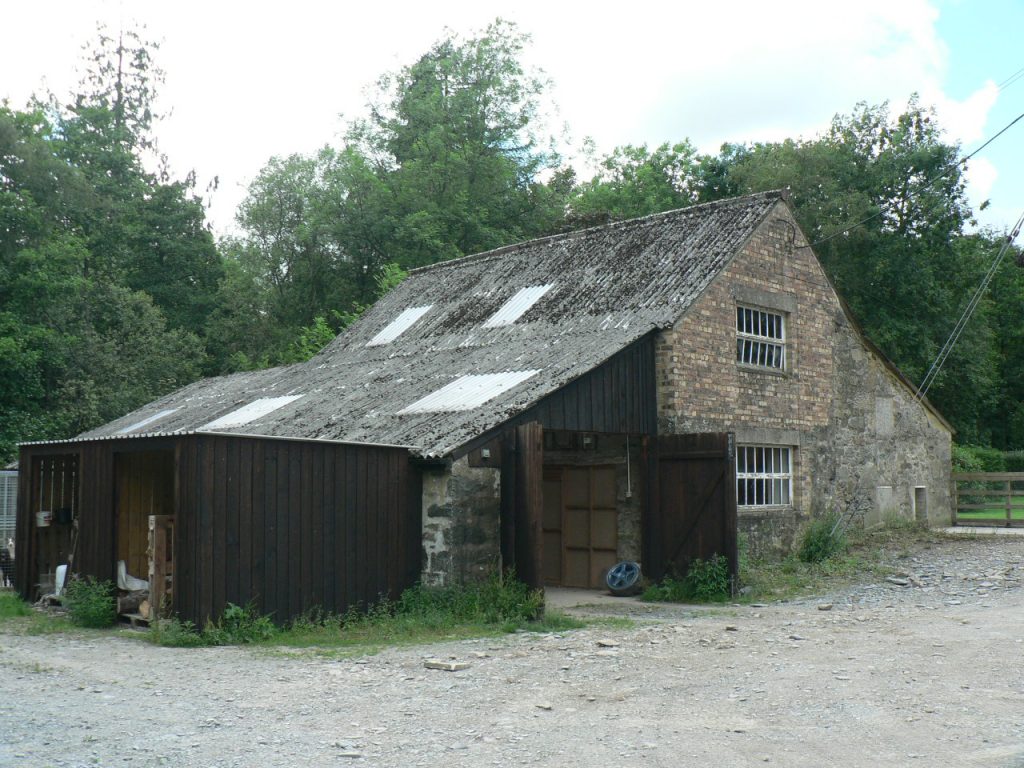
The Perthshire Directory lists him as blacksmith at Tullybannochar in 1889-1890 but by 1891 the family had moved to a forge at Kinkell Bridge, just on the south side of the River Earn. I had the pleasure of seeing around the forge and the extended house by the friendly owner around 2003. Charles Douglas was still there in 1901. From the 1891 census we know there were 5 rooms with windows. His wife was not, however: Jane was living in her son in law’s house.
The Perthshire Crieff Strathearn Local History website, explains that the bridge at Kinkell replaced a local ferry in the 1790s. It was well placed on a drove road for those bringing livestock south. The toll house took payment from those crossing over to help maintain the bridge and road. Charles’s smithy was in a good position to provide service, like a well-placed roadside garage now.
Once again the Valuation Rolls have been useful in giving more information about the family at this time. Charles was the tenant occupier of the house and smithy at Kinkell, the value assessed at £14-4-6. This was part of the Strathallan Estate, as cousins Douglas and Ishbel McEwan had suggested (verbally). He was paying £2-2-8 yearly in rent. Charles was also the tenant of the Old Toll House at Kinkell, on the Estate of Millearne, Trinity and Gask. The proprietor was Arthur Drummond-Forbes. Charles was not actually living there according to the Valuation Roll – son in law Alexander Fergusson was- presumably with his family and his mother in law. The annual value was given as £4-0-0 and that is the rent being paid. It is unclear whether Charles was paid the rent or a portion of it and then paid it on or whether he paid the rent for everything in his name. According to Ancestry, Alexander Fergusson had been living there in this way since 1894.
In 1901 Charles and his daughter Annie (described as a general domestic servant) were the only inhabitants of the smithy at Kinkell. Whether this was normal is not known. Charles registered the birth of a grandson, Alexander Ferguson (sic) in 1904, born at the Crosshill smithy. From documents like this registration we know Charles was able to at least write his name.
Find My Past has access to newspaper scans from the British Isles. The Dundee Courier of 13 March 1907 includes an account of the funeral of Mr Robert Gardiner of Henhill, Forteviot to Kinkell Churchyard. It was a well attended funeral and one of those attending was Charles Douglas of Kinkell.
On 17th November 1908 the same newspaper reported a dispensing sale at Kinkell Smithy on Wednesday November 18th. Charles must have been retiring- and presumably son on law Alexander Fergusson had no need for the equipment- as it was described as a “dispensing sale of stock, crop and smithy effects… Hay and Co favoured with instructions from Mr Chas Douglas, will sell by public roup, at above place… “
The Strathearn Herald on 28th November then reported on the sale itself, giving prices gained:
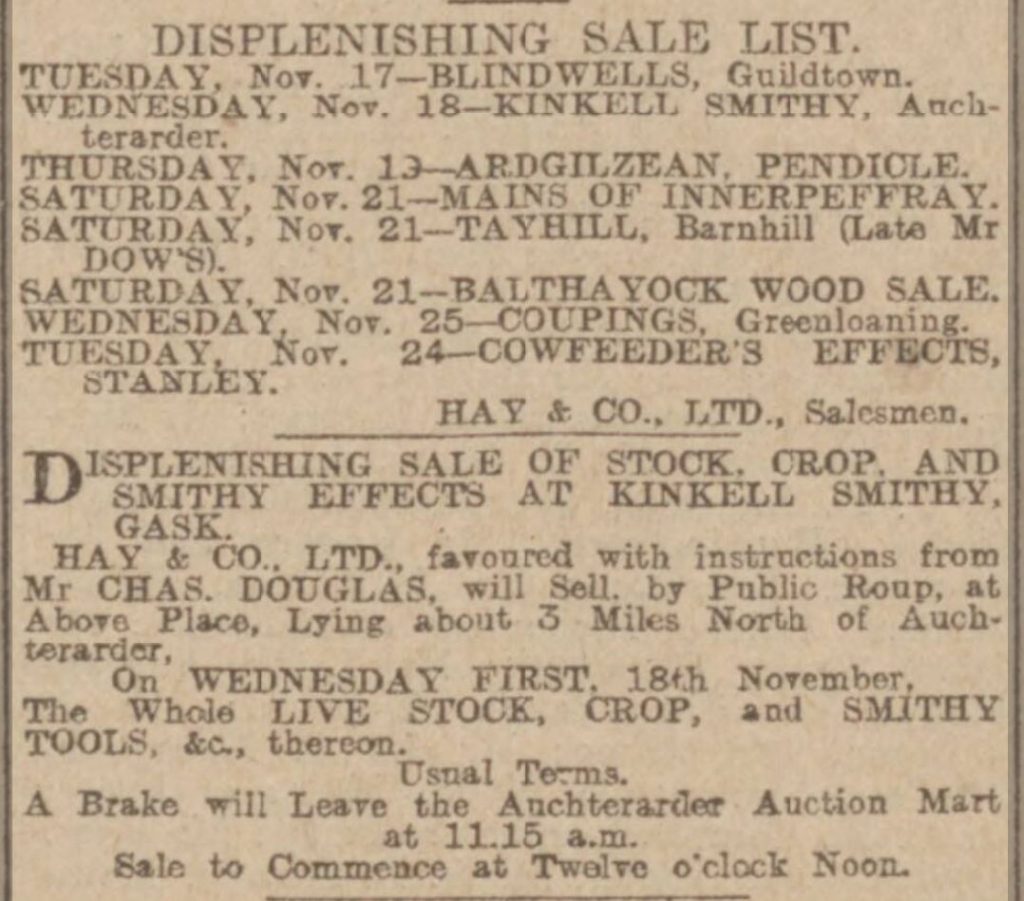
The Old Toll House at Blackford; I presume this is where Jane Ann Clark died in 1918. It is now derelict.
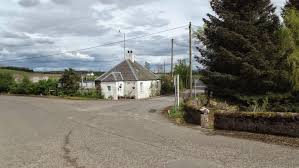
Jane’s Other Child
In 2010 I made another discovery by chance, courtesy of Ancestry’s message boards. According to a woman named Jean Davis, Jane Ann Clark had already had a daughter named Georgina before she married Charles Douglas the blacksmith in 1861! I have not had success in eliciting more information from this descendant unfortunately. However, Georgina took her farmer father’s surname (MacBean) and his name is on the birth certificate although he is noted as not being present. Since the child was born at 1am at her parent’s house perhaps this is not surprising. Her birth was not registered for 7 weeks (SR 102/00 0031).
Daughter Georgina went on to marry a James MacLean in 1891 at Alvie in Inverness-shire (SR 090/B0 0002). She probably died at Advie, Morayshire in 1952.
According to the 1891 census James and Georgina were living at what looks like Inverdrui Farm house in Rothiemurchus, Inverness-shire. From one birth I’ve located and the 1901 census it seems that they had children Elizabeth Isabella MacLean (born 9/8/1891) and then moved to Duthil as that is where son William was born c 1893. They were in Alvie, Nairn, when James, Jessie and Alexander Duncan were born. They moved to Ballenreach Farm house around 1899 as that is where Donald was born and they were still at that house in 1901. The 1901 census includes a farm servant named James MacStephen and an Isabella MacPherson MacLean who was 15. This would put her birth some 5 years before the couple married and I suspect that she was the daughter of one or other but not of both parents.
The Valuation Rolls show (VR 110/7/469) that James was a tenant occupier of the farm of Balinreach, Estate of Glenferness in 1905. It was owned by the Right Honourable Earl of Leven and Melville. He was paying £47-1-3 a year in rent.
The 1911 census shows the couple living at Newton of Belivat in a house where 3 rooms had windows. James and Georgina both spoke Gaelic and English. They had been married 21 years and had now had 10 children, all of whom were still alive. At home still were James, Alexander and Donald. The children born since the last census were Robert, 9, George, 6 and Jane A who was four. Presumably she was named after her grandmother (Census 120/00 005/00 001).
The 1915 valuation rolls show a James MacLean, shepherd, as inhabitant of house 33, on the estate of Lethen and Coulmony. Six owners are cited for the estate. Rent was £4-10. I wonder if this is son James rather than father.
Strathearn Herald of 28th November 1908, showing the proceeds of the sale of Charles Douglas’s smithy. He was now around 69 years of age and was to live on for around 20 years.